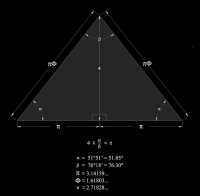If Pi (3.141592653589...It's all I can remember right now)...Anyways if Pi is on going and "infinate"...how the hell do you get to "4". Also the Phi ratio and Pi, as featured together in the Great Pyramid would be a great jumping off point for a convo. Anyone care to subject this human brain to their version of what the significance of this mathematical "coincidence" is. Anyone down for convos on Vortex Math, the "369" or Frequency 432...please HMU.

Enjoy being online again!
Welcome to the community of good people who base their values on evidence and appreciate civil discourse - the social network you will enjoy.Create your free account
9 comments
Feel free to reply to any comment by clicking the "Reply" button.How do we get from Pi to 4? Add (4 - Pi) to Pi.
There are infinite numbers between whole numbers. We should have a problem of getting from 0.999999...(repeating) to 1, if we have a problem of getting from Pi to 4. And if we have a problem of getting to 1, well...we should still be living in the stone age.
As for why 4 equates to the height of that triangle in your diagram? If those equations do actually work out, the answer is Pythagoras' theorem. I've not looked into whether the numbers in your triangle actually work out. I'm only assuming that they do.
Our brains have evolved to notice patterns and give qualities and meaning to them. Qualities like "coincidental". Or meanings like "secret knowledge".
The number line is made of rational and irrational numbers. rationals are all the numbers that can be presented as simple fractions like n/m. They include the integers because they may be presented as n/1.
The irratinal numbers are made of Alebraic and Transcendental. The Algebraic are roots of polynomials. What is left is trancendental. e and pi are two examples of trancendentals. Phi is algebraic as is the square root of 2.
The vast majority of numbers are trancendental.
All the irrationals, when represented as decimals, have infinite number of digits without any recurring patterns.
0, 1, pi , and e arethe building blocks of Math, indeed the universe.
Leonard Euler, probably the greatest mathematician in history (and for sure the most prolific), put it all in one formula. It is called Euler's identity:
"If Pi (3.141592653589...It's all I can remember right now)...Anyways if Pi is on going and "infinate"...how the hell do you get to "4"" could be seen as a varient of Zeno's Dichotomy Paradox, which argues that for a person to move from one place to another she must first move half the distance, then half the remaining distance, then half of that remaining distance and so on - an infinite number of tasks, thus making it impossible that she will ever arrive at her destination. Fortunately, when we count we break it down into units - counting from 3 to 4 can be easily accomplished by using units of 1, tenths of one, hundredths of one or any other unit you select; it's only if you want to count every possible decimal between them that you can never get to 4.
Pi will never reach 4, it will always get closer but never shall it reach 4, It is an infinite approach to the number 4 but will never share the value as it cannot get there. It is an interesting thought that religion touts eternal life. Eternity is infinity. No begin and no end. Ergo, all living matter is eternal. When we die, only our self transits into another form of energy
Enjoy being online again!
Welcome to the community of good people who base their values on evidence and appreciate civil discourse - the social network you will enjoy.Create your free account
Share this post
Categories
Agnostic does not evaluate or guarantee the accuracy of any content. Read full disclaimer.








